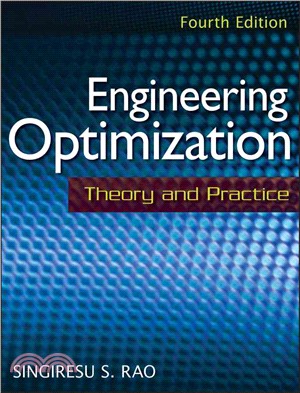ENGINEERING OPTIMIZATION : THEORY AND PRACTIC 4/E
商品資訊
相關商品
商品簡介
作者簡介
名人/編輯推薦
目次
商品簡介
Technology/Engineering/Mechanical
Helps you move from theory to optimizing engineering systems in almost any industry
Now in its Fourth Edition, Professor Singiresu Rao's acclaimed text Engineering Optimization enables readers to quickly master and apply all the important optimization methods in use today across a broad range of industries. Covering both the latest and classical optimization methods, the text starts off with the basics and then progressively builds to advanced principles and applications.
This comprehensive text covers nonlinear, linear, geometric, dynamic, and stochastic programming techniques as well as more specialized methods such as multiobjective, genetic algorithms, simulated annealing, neural networks, particle swarm optimization, ant colony optimization, and fuzzy optimization. Each method is presented in clear, straightforward language, making even the more sophisticated techniques easy to grasp. Moreover, the author provides:
Case examples that show how each method is applied to solve real-world problems across a variety of industries
Review questions and problems at the end of each chapter to engage readers in applying their newfound skills and knowledge
Examples that demonstrate the use of MATLAB® for the solution of different types of practical optimization problems
References and bibliography at the end of each chapter for exploring topics in greater depth
Answers to Review Questions available on the author's Web site to help readers to test their understanding of the basic concepts
With its emphasis on problem-solving and applications, Engineering Optimization is ideal for upper-level undergraduates and graduate students in mechanical, civil, electrical, chemical, and aerospace engineering. In addition, the text helps practicing engineers in almost any industry design improved, more efficient systems at less cost.
Helps you move from theory to optimizing engineering systems in almost any industry
Now in its Fourth Edition, Professor Singiresu Rao's acclaimed text Engineering Optimization enables readers to quickly master and apply all the important optimization methods in use today across a broad range of industries. Covering both the latest and classical optimization methods, the text starts off with the basics and then progressively builds to advanced principles and applications.
This comprehensive text covers nonlinear, linear, geometric, dynamic, and stochastic programming techniques as well as more specialized methods such as multiobjective, genetic algorithms, simulated annealing, neural networks, particle swarm optimization, ant colony optimization, and fuzzy optimization. Each method is presented in clear, straightforward language, making even the more sophisticated techniques easy to grasp. Moreover, the author provides:
Case examples that show how each method is applied to solve real-world problems across a variety of industries
Review questions and problems at the end of each chapter to engage readers in applying their newfound skills and knowledge
Examples that demonstrate the use of MATLAB® for the solution of different types of practical optimization problems
References and bibliography at the end of each chapter for exploring topics in greater depth
Answers to Review Questions available on the author's Web site to help readers to test their understanding of the basic concepts
With its emphasis on problem-solving and applications, Engineering Optimization is ideal for upper-level undergraduates and graduate students in mechanical, civil, electrical, chemical, and aerospace engineering. In addition, the text helps practicing engineers in almost any industry design improved, more efficient systems at less cost.
作者簡介
Singiresu S. Rao, PhD, is a Professor and Chairman of the Department of Mechanical Engineering at the University of Miami. Dr. Rao has published more than 175 technical papers in internationally respected journals and more than 150 papers in conference proceedings in the areas of engineering optimization, reliability-based design, fuzzy systems, uncertainty models, structural and mechanical design, and vibration engineering. He has authored several books, including The Finite Element Method in Engineering, Mechanical Vibrations, Vibration of Continuous Systems, Reliability-Based Design, and Applied Numerical Methods for Engineers and Scientists.
名人/編輯推薦
"He presents an updated textbook addressing the techniques and applications of engineering optimization for the efficient and economical design and production of products and systems. The material has been used extensively by the author to teach optimum design and engineering optimization courses at the advanced-undergraduate and graduate levels at a number of universities." (Book News, August 2009)
目次
Preface.
1 Introduction to Optimization.
1.1 Introduction.
1.2 Historical Development.
1.3 Engineering Applications of Optimization.
1.4 Statement of an Optimization Problem.
1.5 Classification of Optimization Problems.
1.6 Optimization Techniques.
1.7 Engineering Optimization Literature.
1.8 Solution of Optimization Problems Using MATLAB.
References and Bibliography.
Review Questions.
Problems.
2 Classical Optimization Techniques.
2.1 Introduction.
2.2 Single-Variable Optimization.
2.3 Multivariable Optimization with No Constraints.
2.4 Multivariable Optimization with Equality Constraints.
2.5 Multivariable Optimization with Inequality Constraints.
2.6 Convex Programming Problem.
References and Bibliography.
Review Questions.
Problems.
3 Linear Programming I: Simplex Method.
3.1 Introduction.
3.2 Applications of Linear Programming.
3.3 Standard Form of a Linear Programming Problem.
3.4 Geometry of Linear Programming Problems.
3.5 Definitions and Theorems.
3.6 Solution of a System of Linear Simultaneous Equations.
3.7 Pivotal Reduction of a General System of Equations.
3.8 Motivation of the Simplex Method.
3.9 Simplex Algorithm.
3.10 Two Phases of the Simplex Method.
3.11 MATLAB Solution of LP Problems.
References and Bibliography.
Review Questions.
Problems.
4 Linear Programming II: Additional Topics and Extensions.
4.1 Introduction.
4.2 Revised Simplex Method.
4.3 Duality in Linear Programming.
4.4 Decomposition Principle.
4.5 Sensitivity or Postoptimality Analysis.
4.6 Transportation Problem.
4.7 Karmarkar’s Interior Method.
4.8 Quadratic Programming.
4.9 MATLAB Solutions.
References and Bibliography.
Review Questions.
Problems.
5 Nonlinear Programming I: One-Dimensional Minimization Methods.
5.1 Introduction.
5.2 Unimodal Function.
ELIMINATION METHODS.
5.3 Unrestricted Search.
5.4 Exhaustive Search.
5.5 Dichotomous Search.
5.6 Interval Halving Method.
5.7 Fibonacci Method.
5.8 Golden Section Method.
5.9 Comparison of Elimination Methods.
INTERPOLATION METHODS.
5.10 Quadratic Interpolation Method.
5.11 Cubic Interpolation Method.
5.12 Direct Root Methods.
5.13 Practical Considerations.
5.14 MATLAB Solution of One-Dimensional Minimization Problems.
References and Bibliography.
Review Questions.
Problems.
6 Nonlinear Programming II: Unconstrained Optimization Techniques.
6.1 Introduction.
DIRECT SEARCH METHODS.
6.2 Random Search Methods.
6.3 Grid Search Method.
6.4 Univariate Method.
6.5 Pattern Directions.
6.6 Powell’s Method.
6.7 Simplex Method.
INDIRECT SEARCH (DESCENT) METHODS.
6.8 Gradient of a Function.
6.9 Steepest Descent (Cauchy) Method.
6.10 Conjugate Gradient (Fletcher–Reeves) Method.
6.11 Newton’s Method.
6.12 Marquardt Method.
6.13 Quasi-Newton Methods.
6.14 Davidon–Fletcher–Powell Method.
6.15 Broyden–Fletcher–Goldfarb–Shanno Method.
6.16 Test Functions.
6.17 MATLAB Solution of Unconstrained Optimization Problems.
References and Bibliography.
Review Questions.
Problems.
7 Nonlinear Programming III: Constrained Optimization Techniques.
7.1 Introduction.
7.2 Characteristics of a Constrained Problem.
DIRECT METHODS.
7.3 Random Search Methods.
7.4 Complex Method.
7.5 Sequential Linear Programming.
7.6 Basic Approach in the Methods of Feasible Directions.
7.7 Zoutendijk’s Method of Feasible Directions.
7.8 Rosen’s Gradient Projection Method.
7.9 Generalized Reduced Gradient Method.
7.10 Sequential Quadratic Programming.
INDIRECT METHODS.
7.11 Transformation Techniques.
7.12 Basic Approach of the Penalty Function Method.
7.13 Interior Penalty Function Method.
7.14 Convex Programming Problem.
7.15 Exterior Penalty Function Method.
7.16 Extrapolation Techniques in the Interior Penalty Function Method.
7.17 Extended Interior Penalty Function Methods.
7.18 Penalty Function Method for Problems with Mixed Equality and Inequality Constraints.
7.19 Penalty Function Method for Parametric Constraints.
7.20 Augmented Lagrange Multiplier Method.
7.21 Checking the Convergence of Constrained Optimization Problems.
7.22 Test Problems.
7.23 MATLAB Solution of Constrained Optimization Problems.
References and Bibliography.
Review Questions.
Problems.
8 Geometric Programming.
8.1 Introduction.
8.2 Posynomial.
8.3 Unconstrained Minimization Problem.
8.4 Solution of an Unconstrained Geometric Programming Program Using Differential Calculus.
8.5 Solution of an Unconstrained Geometric Programming Problem Using Arithmetic–Geometric Inequality.
8.6 Primal–Dual Relationship and Sufficiency Conditions in the Unconstrained Case.
8.7 Constrained Minimization.
8.8 Solution of a Constrained Geometric Programming Problem.
8.9 Primal and Dual Programs in the Case of Less-Than Inequalities.
8.10 Geometric Programming with Mixed Inequality Constraints.
8.11 Complementary Geometric Programming.
8.12 Applications of Geometric Programming.
References and Bibliography.
Review Questions.
Problems.
9 Dynamic Programming.
9.1 Introduction.
9.2 Multistage Decision Processes.
9.3 Concept of Suboptimization and Principle of Optimality.
9.4 Computational Procedure in Dynamic Programming.
9.5 Example Illustrating the Calculus Method of Solution.
9.6 Example Illustrating the Tabular Method of Solution.
9.7 Conversion of a Final Value Problem into an Initial Value Problem.
9.8 Linear Programming as a Case of Dynamic Programming.
9.9 Continuous Dynamic Programming.
9.10 Additional Applications.
References and Bibliography.
Review Questions.
Problems.
10 Integer Programming.
10.1 Introduction 588.
INTEGER LINEAR PROGRAMMING.
10.2 Graphical Representation.
10.3 Gomory’s Cutting Plane Method.
10.4 Balas’ Algorithm for Zero–One Programming Problems.
INTEGER NONLINEAR PROGRAMMING.
10.5 Integer Polynomial Programming.
10.6 Branch-and-Bound Method.
10.7 Sequential Linear Discrete Programming.
10.8 Generalized Penalty Function Method.
10.9 Solution of Binary Programming Problems Using MATLAB.
References and Bibliography.
Review Questions.
Problems.
11 Stochastic Programming.
11.1 Introduction.
11.2 Basic Concepts of Probability Theory.
11.3 Stochastic Linear Programming.
11.4 Stochastic Nonlinear Programming.
11.5 Stochastic Geometric Programming.
References and Bibliography.
Review Questions.
Problems.
12 Optimal Control and Optimality Criteria Methods.
12.1 Introduction.
12.2 Calculus of Variations.
12.3 Optimal Control Theory.
12.4 Optimality Criteria Methods.
References and Bibliography.
Review Questions.
Problems.
13 Modern Methods of Optimization.
13.1 Introduction.
13.2 Genetic Algorithms.
13.3 Simulated Annealing.
13.4 Particle Swarm Optimization.
13.5 Ant Colony Optimization.
13.6 Optimization of Fuzzy Systems.
13.7 Neural-Network-Based Optimization.
References and Bibliography.
Review Questions.
Problems.
14 Practical Aspects of Optimization.
14.1 Introduction.
14.2 Reduction of Size of an Optimization Problem.
14.3 Fast Reanalysis Techniques.
14.4 Derivatives of Static Displacements and Stresses.
14.5 Derivatives of Eigenvalues and Eigenvectors.
14.6 Derivatives of Transient Response.
14.7 Sensitivity of Optimum Solution to Problem Parameters.
14.8 Multilevel Optimization.
14.9 Parallel Processing.
14.10 Multiobjective Optimization.
14.11 Solution of Multiobjective Problems Using MATLAB.
References and Bibliography.
Review Questions.
Problems.
A Convex and Concave Functions.
B Some Computational Aspects of Optimization.
B.1 Choice of Method.
B.2 Comparison of Unconstrained Methods.
B.3 Comparison of Constrained Methods.
B.4 Availability of Computer Programs.
B.5 Scaling of Design Variables and Constraints.
B.6 Computer Programs for Modern Methods of Optimization.
References and Bibliography.
C Introduction to MATLAB®.
C.1 Features and Special Characters.
C.2 Defining Matrices in MATLAB.
C.3 CREATING m-FILES.
C.4 Optimization Toolbox.
Answers to Selected Problems.
Index.
1 Introduction to Optimization.
1.1 Introduction.
1.2 Historical Development.
1.3 Engineering Applications of Optimization.
1.4 Statement of an Optimization Problem.
1.5 Classification of Optimization Problems.
1.6 Optimization Techniques.
1.7 Engineering Optimization Literature.
1.8 Solution of Optimization Problems Using MATLAB.
References and Bibliography.
Review Questions.
Problems.
2 Classical Optimization Techniques.
2.1 Introduction.
2.2 Single-Variable Optimization.
2.3 Multivariable Optimization with No Constraints.
2.4 Multivariable Optimization with Equality Constraints.
2.5 Multivariable Optimization with Inequality Constraints.
2.6 Convex Programming Problem.
References and Bibliography.
Review Questions.
Problems.
3 Linear Programming I: Simplex Method.
3.1 Introduction.
3.2 Applications of Linear Programming.
3.3 Standard Form of a Linear Programming Problem.
3.4 Geometry of Linear Programming Problems.
3.5 Definitions and Theorems.
3.6 Solution of a System of Linear Simultaneous Equations.
3.7 Pivotal Reduction of a General System of Equations.
3.8 Motivation of the Simplex Method.
3.9 Simplex Algorithm.
3.10 Two Phases of the Simplex Method.
3.11 MATLAB Solution of LP Problems.
References and Bibliography.
Review Questions.
Problems.
4 Linear Programming II: Additional Topics and Extensions.
4.1 Introduction.
4.2 Revised Simplex Method.
4.3 Duality in Linear Programming.
4.4 Decomposition Principle.
4.5 Sensitivity or Postoptimality Analysis.
4.6 Transportation Problem.
4.7 Karmarkar’s Interior Method.
4.8 Quadratic Programming.
4.9 MATLAB Solutions.
References and Bibliography.
Review Questions.
Problems.
5 Nonlinear Programming I: One-Dimensional Minimization Methods.
5.1 Introduction.
5.2 Unimodal Function.
ELIMINATION METHODS.
5.3 Unrestricted Search.
5.4 Exhaustive Search.
5.5 Dichotomous Search.
5.6 Interval Halving Method.
5.7 Fibonacci Method.
5.8 Golden Section Method.
5.9 Comparison of Elimination Methods.
INTERPOLATION METHODS.
5.10 Quadratic Interpolation Method.
5.11 Cubic Interpolation Method.
5.12 Direct Root Methods.
5.13 Practical Considerations.
5.14 MATLAB Solution of One-Dimensional Minimization Problems.
References and Bibliography.
Review Questions.
Problems.
6 Nonlinear Programming II: Unconstrained Optimization Techniques.
6.1 Introduction.
DIRECT SEARCH METHODS.
6.2 Random Search Methods.
6.3 Grid Search Method.
6.4 Univariate Method.
6.5 Pattern Directions.
6.6 Powell’s Method.
6.7 Simplex Method.
INDIRECT SEARCH (DESCENT) METHODS.
6.8 Gradient of a Function.
6.9 Steepest Descent (Cauchy) Method.
6.10 Conjugate Gradient (Fletcher–Reeves) Method.
6.11 Newton’s Method.
6.12 Marquardt Method.
6.13 Quasi-Newton Methods.
6.14 Davidon–Fletcher–Powell Method.
6.15 Broyden–Fletcher–Goldfarb–Shanno Method.
6.16 Test Functions.
6.17 MATLAB Solution of Unconstrained Optimization Problems.
References and Bibliography.
Review Questions.
Problems.
7 Nonlinear Programming III: Constrained Optimization Techniques.
7.1 Introduction.
7.2 Characteristics of a Constrained Problem.
DIRECT METHODS.
7.3 Random Search Methods.
7.4 Complex Method.
7.5 Sequential Linear Programming.
7.6 Basic Approach in the Methods of Feasible Directions.
7.7 Zoutendijk’s Method of Feasible Directions.
7.8 Rosen’s Gradient Projection Method.
7.9 Generalized Reduced Gradient Method.
7.10 Sequential Quadratic Programming.
INDIRECT METHODS.
7.11 Transformation Techniques.
7.12 Basic Approach of the Penalty Function Method.
7.13 Interior Penalty Function Method.
7.14 Convex Programming Problem.
7.15 Exterior Penalty Function Method.
7.16 Extrapolation Techniques in the Interior Penalty Function Method.
7.17 Extended Interior Penalty Function Methods.
7.18 Penalty Function Method for Problems with Mixed Equality and Inequality Constraints.
7.19 Penalty Function Method for Parametric Constraints.
7.20 Augmented Lagrange Multiplier Method.
7.21 Checking the Convergence of Constrained Optimization Problems.
7.22 Test Problems.
7.23 MATLAB Solution of Constrained Optimization Problems.
References and Bibliography.
Review Questions.
Problems.
8 Geometric Programming.
8.1 Introduction.
8.2 Posynomial.
8.3 Unconstrained Minimization Problem.
8.4 Solution of an Unconstrained Geometric Programming Program Using Differential Calculus.
8.5 Solution of an Unconstrained Geometric Programming Problem Using Arithmetic–Geometric Inequality.
8.6 Primal–Dual Relationship and Sufficiency Conditions in the Unconstrained Case.
8.7 Constrained Minimization.
8.8 Solution of a Constrained Geometric Programming Problem.
8.9 Primal and Dual Programs in the Case of Less-Than Inequalities.
8.10 Geometric Programming with Mixed Inequality Constraints.
8.11 Complementary Geometric Programming.
8.12 Applications of Geometric Programming.
References and Bibliography.
Review Questions.
Problems.
9 Dynamic Programming.
9.1 Introduction.
9.2 Multistage Decision Processes.
9.3 Concept of Suboptimization and Principle of Optimality.
9.4 Computational Procedure in Dynamic Programming.
9.5 Example Illustrating the Calculus Method of Solution.
9.6 Example Illustrating the Tabular Method of Solution.
9.7 Conversion of a Final Value Problem into an Initial Value Problem.
9.8 Linear Programming as a Case of Dynamic Programming.
9.9 Continuous Dynamic Programming.
9.10 Additional Applications.
References and Bibliography.
Review Questions.
Problems.
10 Integer Programming.
10.1 Introduction 588.
INTEGER LINEAR PROGRAMMING.
10.2 Graphical Representation.
10.3 Gomory’s Cutting Plane Method.
10.4 Balas’ Algorithm for Zero–One Programming Problems.
INTEGER NONLINEAR PROGRAMMING.
10.5 Integer Polynomial Programming.
10.6 Branch-and-Bound Method.
10.7 Sequential Linear Discrete Programming.
10.8 Generalized Penalty Function Method.
10.9 Solution of Binary Programming Problems Using MATLAB.
References and Bibliography.
Review Questions.
Problems.
11 Stochastic Programming.
11.1 Introduction.
11.2 Basic Concepts of Probability Theory.
11.3 Stochastic Linear Programming.
11.4 Stochastic Nonlinear Programming.
11.5 Stochastic Geometric Programming.
References and Bibliography.
Review Questions.
Problems.
12 Optimal Control and Optimality Criteria Methods.
12.1 Introduction.
12.2 Calculus of Variations.
12.3 Optimal Control Theory.
12.4 Optimality Criteria Methods.
References and Bibliography.
Review Questions.
Problems.
13 Modern Methods of Optimization.
13.1 Introduction.
13.2 Genetic Algorithms.
13.3 Simulated Annealing.
13.4 Particle Swarm Optimization.
13.5 Ant Colony Optimization.
13.6 Optimization of Fuzzy Systems.
13.7 Neural-Network-Based Optimization.
References and Bibliography.
Review Questions.
Problems.
14 Practical Aspects of Optimization.
14.1 Introduction.
14.2 Reduction of Size of an Optimization Problem.
14.3 Fast Reanalysis Techniques.
14.4 Derivatives of Static Displacements and Stresses.
14.5 Derivatives of Eigenvalues and Eigenvectors.
14.6 Derivatives of Transient Response.
14.7 Sensitivity of Optimum Solution to Problem Parameters.
14.8 Multilevel Optimization.
14.9 Parallel Processing.
14.10 Multiobjective Optimization.
14.11 Solution of Multiobjective Problems Using MATLAB.
References and Bibliography.
Review Questions.
Problems.
A Convex and Concave Functions.
B Some Computational Aspects of Optimization.
B.1 Choice of Method.
B.2 Comparison of Unconstrained Methods.
B.3 Comparison of Constrained Methods.
B.4 Availability of Computer Programs.
B.5 Scaling of Design Variables and Constraints.
B.6 Computer Programs for Modern Methods of Optimization.
References and Bibliography.
C Introduction to MATLAB®.
C.1 Features and Special Characters.
C.2 Defining Matrices in MATLAB.
C.3 CREATING m-FILES.
C.4 Optimization Toolbox.
Answers to Selected Problems.
Index.
主題書展
更多
主題書展
更多書展本週66折
您曾經瀏覽過的商品
購物須知
為了保護您的權益,「三民網路書店」提供會員七日商品鑑賞期(收到商品為起始日)。
若要辦理退貨,請在商品鑑賞期內寄回,且商品必須是全新狀態與完整包裝(商品、附件、發票、隨貨贈品等)否則恕不接受退貨。
























